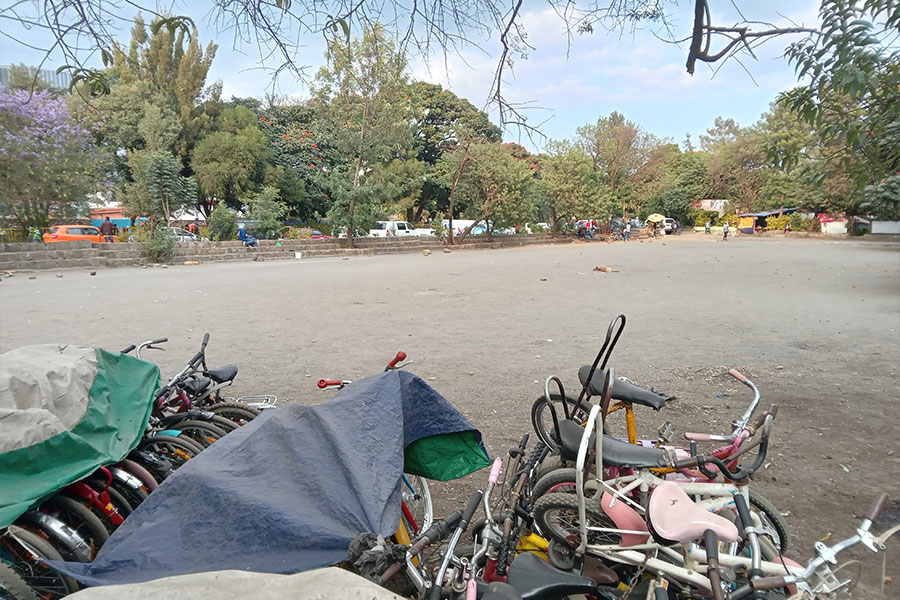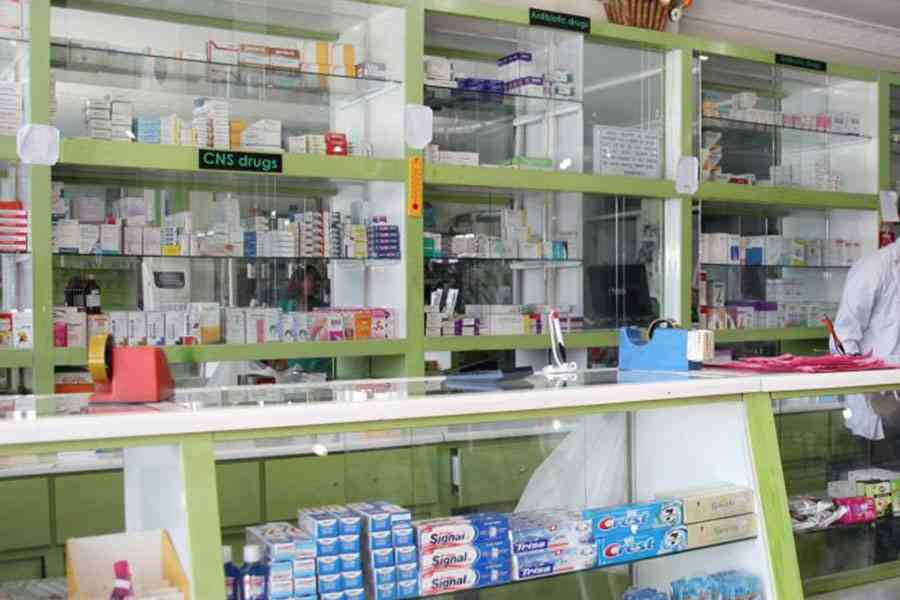
View From Arada | Nov 12,2022
The modern-day social hub, Bole Road, has seen yet another transformation with multiple landmarks demolished— Olympia is no more. A grey hue has taken over, accompanied by commercial buildings which are required to match their glass tilt while apartments owned by the Federal Housing Corporation (FHC) have painted over their iconic dark brown colour.
Africare Bole Apartments (297) comprises 32 residents in two blocks who have been asked to cover the cost of renovation. They said the requirements from FHC included the interior house as well but settled for the outdoors and balcony after negotiation. According to them, contributing 6,000 Br each was beyond their capacity but they had to comply, fearing eviction from the property.
"We can't afford this," said one of the residents. "Most of us live on a pension fund."
There are close to 20,000 residential apartment units managed by the Corporation. The tenants, mostly residing on the premises for over two decades pay nearly 650 Br monthly rent. According to officials, the renovation is a small price to pay for a place rented at a low price point.
Amanuel Tesfaye, communication director, said it is important to be part of the development plan. He defended his Corporation saying that the agreement was reached based on mutual understanding.
"Anyone saying otherwise is discrediting our name," he said.
While Amanuel believes that the houses need renovation, the corridor development plan that demanded keeping a certain standard came a tad bit too suddenly before allocating the necessary budget.
Addis Abeba is undergoing a transformative phase with the ruling Prosperity Party taking aesthetics as a major reform. A network of gleaming corridors inspired by Prime Minister Abiy Ahmed’s call to connect the beautification projects scattered across the city guise under the banner of "smart city". He has assigned high-brass officials to oversee each part including Mayor Adanech Abiebe who took the eight-kilometre stretch beginning at the recently inaugurated Adwa Victory Memorial in Piassa.
Moges Tibebu, head of the Ethiopian Roads Authority, is in charge of the 10Km corridor that encompasses an extensive stretch from Arat Kilo, passing through Friendship Park and Abrehot Library and extending across the renovated Mesqel Square to Bole International Airport, bulldozing sideways on Africa Avenue (Bole Road).
To keep up with the appearance of the multi-billion birr project, new standards are implemented.
For the last few months, a group of people from the Building Permit & Construction Authority had been requesting buildings to match the colours using 20 sets of the European RAL standard system. It was shortly followed by mandatory lighting with a set of standards.
While warm white light is mandatory for all, the officials classified the required building lighting into three categories: uplights and downlights, pixels and LED, depending on the number of storeys and the width of the construction area.
Addis Demeke, team leader of the building permit, said the lighting standard helps to keep the area's businesses uniform and make it marketable at night.
"It's a win-win for all," he said.
Consequently, a letter signed by the Head of Addis Abeba Trade Bureau Biniam Mikru surfaced last week requiring businesses and service providers to stay open at least until 9 PM. Officials hope to revive economic activities and work hours in the corridors.
Over 1,100 owners have submitted their design proposals so far, to meet the standards imposed by the City. One of them is Tropical Mall with over 100 shops and boutiques inside. It has to reimage its entire lighting system and include pixel lighting on its 13-storey building.
Deru Reta, the general manager, was caught off guard when officials demanded the change with little notice.
"I've never even heard of it," he told Fortune.
Apart from being worried about the expenses, which he estimates will cost hundreds of millions, he is unsure where to source the necessary materials.
Other buildings, such as Friendship Mall, have faced similar predicaments. Managers are uncertain about how to comply with the demands and the conditions they are subjected to. The sudden imposition of these requirements has left many business owners scrambling to find solutions
"It's like being told to construct a new building," he said.
Advertisement is another area where new standards have been set. Authorities now require the use of light boxes, digital screens, and LED displays, removing traditional banners. According to Awel Jemal, an outdoor advertisement expert, proposals and service charges range from 800 Br to 5,000 Br. He said this is necessary to keep up with the urbanisation objective.
Beginning in Bole District, as businesses and residents adapt to these new regulations, the transition to a digitally-driven advertisement is poised for other corridors as well, said Awel.
The standard applies to all new construction projects, introducing a rigorous bureaucratic framework for obtaining permission and commencing work. About 837 businesses have gotten permission while over a thousand have been stripped of their ads for not meeting the standards.
Ayele Tesfaye, owner of Rahel Juice operating on Airport Road for the past four years, finds himself in a perplexing situation. Recently, officials asked him to remove a newly purchased banner featuring dark-coloured text, stating it did not meet the new standards. However, he said no one explained to him what to do next.
"I don't even know what the standard means," he said.
Ayele faces uncertainty as he waits without banners until further notice. His apprehension stems from the looming financial burden of potentially expensive upgrades.
"We have already been struggling with customer reductions due to corridor expansion," he said.
While some struggle with finances, others like commercial banks are wrestling with time and identity. The banks were asked to digitise their outdoor branding with stringent deadlines that have already passed. However, what is more concerning to most is the lack of clarity on changing their building colours.
Demsew Kassa, secretary general of the Bankers' Association, underscores the industry's plea for extended timelines and enhanced clarity. He attributes the confusion to a potential disconnect between regulatory expectations and operational realities, particularly concerning international branding standards.
"We've requested an extension of time," Demsew said, signalling a unified effort within the sector to navigate these regulatory shifts without compromising brand identity.
A daunting task is ahead for business owners in the corridor areas with unforeseen costs of compliance. In contrast, business is booming for advertisers. The demand for light boxes and LED displays has risen while digital screens are set to cost around 200,000 Br. Akias Teshome, the general manager of Akias Advertising, sees the benefits of the transitions. However, he is concerned about the purchasing power of business owners.
The nearly 20 LED importers are also rejoicing. Over the past three months, LEDCON Manufacturing has sold out over 1,000 rolls of LED lights that were previously stocked for two years. The demand surge has also led to a price increase with costs rising to 200 Br a meter.
Abdi Nuredin, general manager, said the warm white variant, particularly popular for its aesthetic appeal, is in high demand. However, he notes challenges stemming from import duties as high as 65pc, predominantly levied on products imported from China.
Companies like Grace Plc. have also seen growth in their operations. Specialising in designing light boxes and neon lights tailored to client specifications, the company has observed a 10pc increase in demand. According to Jafet Worku, general manager, while current operations are lucrative, future uncertainties loom due to potential fluctuations in raw material prices.
As Addis Abeba strives for an extreme makeover, with enhanced aesthetic standards, the LED and lighting industry emerges as a crucial component of this urban evolution.
A potential tariff increase is looming along with the bright lights. Gebeyew Likassa (PhD), head of Addis Abeba Electric Utility, said most of the businesses use their meters that are expected to run round the clock. He said LEDs provide the same brightness as conventional bulbs but consume 90pc less energy, 15 times longer, requiring less maintenance.
"There have been no consequential effects," he said.
For urban planners, the key lies in communicating the rationale and involving the residents of Addis Abeba in the planning. Anteneh Tesfaye (PhD), architect, urban designer and planner from Addis Abeba University, acknowledges the need for improvements like corridor developments and colour regulations in the city but raises concerns about the implementation process. He believes a successful project should build on the city's social capital, which requires involving the public.
According to Anteneh, countries such as Greece had made mandatory changes in the buildings 50 years ago to blue and white colours, to represent the culture of the people which was united and one. However, for Addis Abeba, which is a hub of diversity, he said a monotonous standard was not objectively articulated.
"It can't be intellectually explained," he said.
He proposes extensive public engagement and well-designed plans that consider aesthetics, environment, and a slower, more thoughtful approach to achieve the city's desired image.
PUBLISHED ON
Jun 29,2024 [ VOL
25 , NO
1261]

View From Arada | Nov 12,2022

Fortune News | May 24,2025

Radar | Dec 12,2023

Radar | Nov 21,2020

Covid-19 | Sep 04,2021

Fortune News | Nov 16,2024

Fortune News | Apr 19,2025

Fortune News | Jul 09,2022

Fortune News | May 17,2025

Featured | Aug 24,2019

Dec 22 , 2024 . By TIZITA SHEWAFERAW
Charged with transforming colossal state-owned enterprises into modern and competitiv...

Aug 18 , 2024 . By AKSAH ITALO
Although predictable Yonas Zerihun's job in the ride-hailing service is not immune to...

Jul 28 , 2024 . By TIZITA SHEWAFERAW
Unhabitual, perhaps too many, Samuel Gebreyohannes, 38, used to occasionally enjoy a couple of beers at breakfast. However, he recently swit...

Jul 13 , 2024 . By AKSAH ITALO
Investors who rely on tractors, trucks, and field vehicles for commuting, transporting commodities, and f...

Jul 5 , 2025
Six years ago, Ethiopia was the darling of international liberal commentators. A year...

Jun 28 , 2025
Meseret Damtie, the assertive auditor general, has never been shy about naming names...

Jun 21 , 2025
A well-worn adage says, “Budget is not destiny, but it is direction.” Examining t...

Jun 14 , 2025
Yet again, the Horn of Africa is bracing for trouble. A region already frayed by wars...